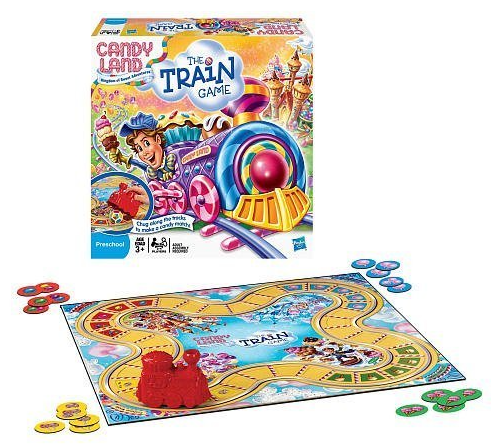 |
| Lilly's Purple Plastic Purse Game - A storytelling memory game |
Lilly's Purple Plastic Purse Game is based on three books written by Kevin Henkes, including one called Lilly's Purple Plastic Purse. However, you do not need to read the books to play the game.
The game is fairly simple: Make up a story using several random cards that are placed in front of you, hide your eyes while someone hides one of those cards in the plastic purse, open your eyes and tell which card is missing. The cards show pictures from his books and include pictures of the characters as well as objects, including Lilly, Baby Julius, Chester & Wilson, Mask, Mr. Slinger, shiny coins, trash can, stars, snacks, teapot, and bike. I may be wrong, but I am thinking that the cards with names will be harder to remember for kids not familiar with the books. But after playing several times they should be easier to remember.
The purse is thin plastic and the mask is a card stock with two ribbons glued on it. It is big enough to tie around my head, so should fit any kid's head. The book(s) are not included. This game won the Best Toy Award from the Oppenhein Toy Portfolio.
Object:
Collect the most story cards.
Set Up:
Shuffle the cards and place them face down on the table. Set the mask and purse nearby.
Play:
The dealer lines up several cards, randomly and face-up, in front of the first player. The number of cards used depends on the age of the player or the difficulty of the challenge you want to pose. Four-year olds get five cards, one for each year and one for luck. The player must then make up a short story using the cards in the order in which they were placed. The player then dons the mask so that he can't see and the dealer selects one of the cards and hides it in the purple purse. He then reshuffles the remaining cards and lines them up again, closing the gap from the missing card so as not to give any clues. The player takes the mask off and tries to identify which card is missing. He opens the purse to check. If he is correct, he keeps the card and the rest of the cards go into the discard pile. If he is incorrect, all the cards go into the discard pile and the next person plays. If the dealer runs out of cards, shuffle the discard pile and use them. Play several rounds and then everyone counts their cards. The player with the most cards is the winner.
Try this:
- Add more cards for a greater challenge. Start with a few and work your way up to 10. Don't mix the cards after hiding one, just close the gap, for an easier game. Reorder the cards in the line before the player is allowed to look for a tougher game.
- Hide more than one card.
- Skip the story and just play as a memory game. Look over the cards for 10 seconds before covering your eyes while one (or more) is hidden.
- Leave the cards in their original order after one is hidden for an easier game.
- Name the cards out loud as you look during a memory game to help you remember them. Rehearse the words in your mind as a card is being hidden.
- Get a pair of sunglasses at the dollar store and hot glue the mask to them. Tying and untying that mask over and over can be a pain.
- Work on visual memory, sequencing, manual dexterity, executive functioning skills, sequencing, socialization skills, process skills, play and leisure exploration and participati
- In the box: Small plastic purse, Lilly blindfold/mask, 36 story cards



